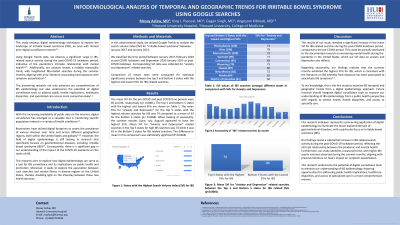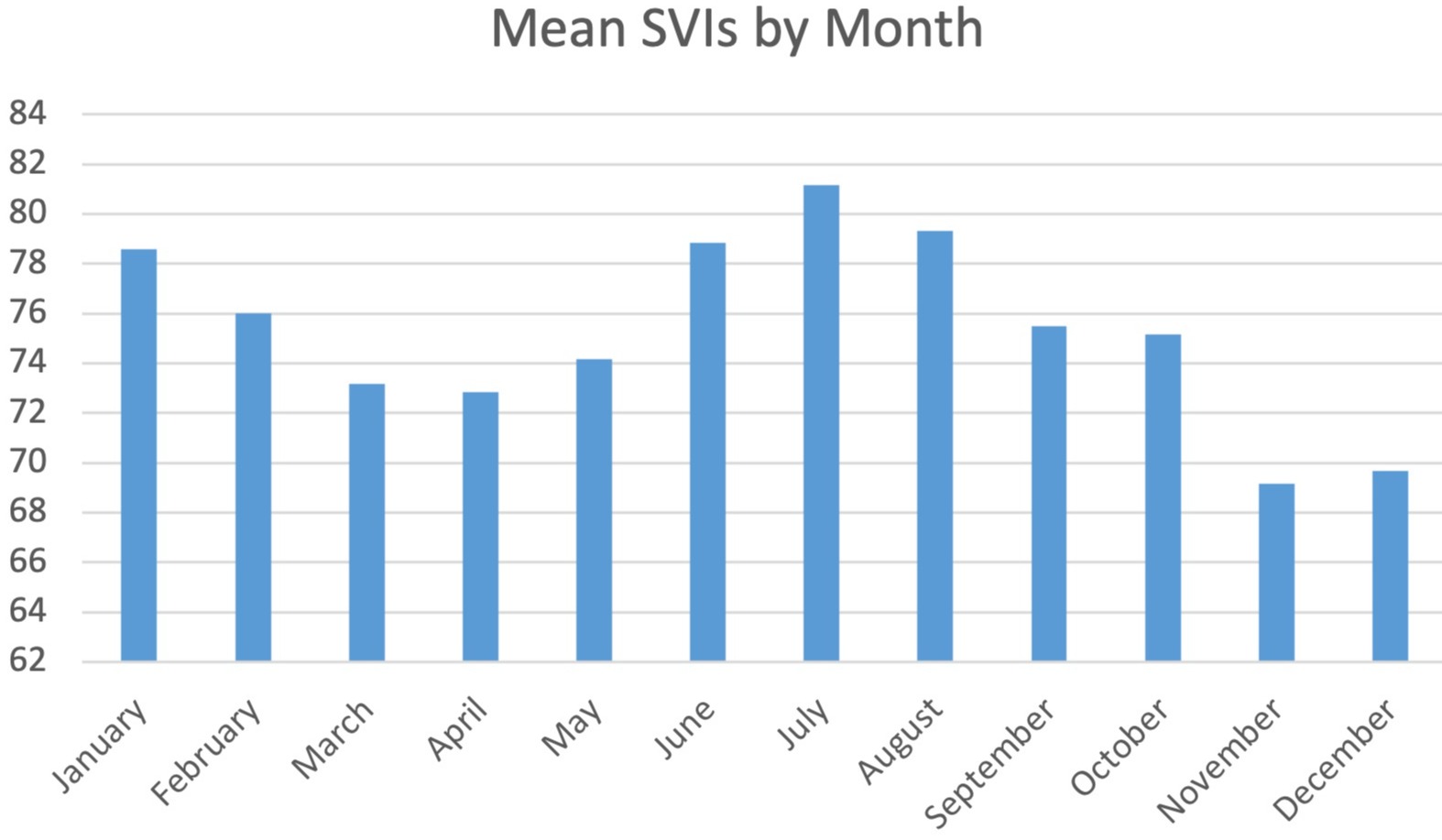Sunday Poster Session
Category: Functional Bowel Disease
P0534 - Infodemiological Analysis of Temporal and Geographic Trends for Irritable Bowel Syndrome Using Google Searches
Sunday, October 22, 2023
3:30 PM - 7:00 PM PT
Location: Exhibit Hall

Has Audio

Mesay H. Asfaw, MD
Howard University Hospital
Takoma Park, MD
Presenting Author(s)
Mesay Asfaw, MD1, Gagan Singh, MD2, King J. Pascual, MD3, Angesom Kibreab, MD2
1Howard University Hospital, Takoma Park, MD; 2Howard University Hospital, Washington, WA; 3Howard University Hospital, Washington, DC
Introduction: With the increasing availability of public data on the internet, digital surveillance has emerged as a valuable tool in monitoring specific population interest in a variety of health conditions. However, the field of digital epidemiology is still lacking in research that specifically focuses on gastrointestinal diseases, including irritable bowel syndrome (IBS). This research aims to explore how digital epidemiology can serve as a tool for IBS surveillance and its implications on public health and promotion.
Methods: In this observational study, we utilized Google Trends to analyze the search volume index (SVI) for “irritable bowel syndrome” between January 2017 and January 2023. We classified the time period between January 2017-February 2020 as pre-COVID lockdown and September 2020-January 2023 as post-COVID lockdown. Corresponding SVI data was collected for “anxiety and depression” related searches. Comparison of means tests were conducted for statistical significance analysis between the top 5 and bottom 5 states with the highest and lowest SVIs for IBS-related searches.
Results: The mean SVI for the pre-COVID and post-COVID time periods were 69 and 84, respectively (p< 0.0001). The top 5 and bottom 5 states with the highest and lowest SVIs are shown on Table 1. The mean SVIs for “anxiety and depression” for the top 5 states with the highest volume searches for IBS was 74 compared to a mean of 63 for the bottom 5 states (p< 0.0268). When looking at seasonality, the summer months (June, July, August) appeared to have the highest SVIs.
Discussion: The results of our study revealed a significant increase in the mean SVI for IBS-related searches during the post-COVID lockdown period compared to the pre-COVID period. This could be partially attributed to the documented research on worsening mental health during the pandemic in the United States, which our SVI data on anxiety and depression also reflects. Regarding seasonality, our findings indicate that the summer months exhibited the highest SVIs for IBS, which is consistent with the literature on IBS whereby heat exposure has been postulated to exacerbate IBS symptoms. To our knowledge, this is the first study to examine IBS temporal and geographic trends from a digital epidemiology approach. Future research should integrate digital surveillance tools to improve our understanding of IBS epidemiology from a public health perspective with regards to mental health, health disparities, and access to specialty care.

Disclosures:
Mesay Asfaw, MD1, Gagan Singh, MD2, King J. Pascual, MD3, Angesom Kibreab, MD2. P0534 - Infodemiological Analysis of Temporal and Geographic Trends for Irritable Bowel Syndrome Using Google Searches, ACG 2023 Annual Scientific Meeting Abstracts. Vancouver, BC, Canada: American College of Gastroenterology.
1Howard University Hospital, Takoma Park, MD; 2Howard University Hospital, Washington, WA; 3Howard University Hospital, Washington, DC
Introduction: With the increasing availability of public data on the internet, digital surveillance has emerged as a valuable tool in monitoring specific population interest in a variety of health conditions. However, the field of digital epidemiology is still lacking in research that specifically focuses on gastrointestinal diseases, including irritable bowel syndrome (IBS). This research aims to explore how digital epidemiology can serve as a tool for IBS surveillance and its implications on public health and promotion.
Methods: In this observational study, we utilized Google Trends to analyze the search volume index (SVI) for “irritable bowel syndrome” between January 2017 and January 2023. We classified the time period between January 2017-February 2020 as pre-COVID lockdown and September 2020-January 2023 as post-COVID lockdown. Corresponding SVI data was collected for “anxiety and depression” related searches. Comparison of means tests were conducted for statistical significance analysis between the top 5 and bottom 5 states with the highest and lowest SVIs for IBS-related searches.
Results: The mean SVI for the pre-COVID and post-COVID time periods were 69 and 84, respectively (p< 0.0001). The top 5 and bottom 5 states with the highest and lowest SVIs are shown on Table 1. The mean SVIs for “anxiety and depression” for the top 5 states with the highest volume searches for IBS was 74 compared to a mean of 63 for the bottom 5 states (p< 0.0268). When looking at seasonality, the summer months (June, July, August) appeared to have the highest SVIs.
Discussion: The results of our study revealed a significant increase in the mean SVI for IBS-related searches during the post-COVID lockdown period compared to the pre-COVID period. This could be partially attributed to the documented research on worsening mental health during the pandemic in the United States, which our SVI data on anxiety and depression also reflects. Regarding seasonality, our findings indicate that the summer months exhibited the highest SVIs for IBS, which is consistent with the literature on IBS whereby heat exposure has been postulated to exacerbate IBS symptoms. To our knowledge, this is the first study to examine IBS temporal and geographic trends from a digital epidemiology approach. Future research should integrate digital surveillance tools to improve our understanding of IBS epidemiology from a public health perspective with regards to mental health, health disparities, and access to specialty care.

Figure: Figure 1 Seasonality of "IBS" related searches by month
Table: Table 1: SVI values of IBS searches amongst different states in comparison with SVIs for Anxiety and Depression
Disclosures:
Mesay Asfaw indicated no relevant financial relationships.
Gagan Singh indicated no relevant financial relationships.
King Pascual indicated no relevant financial relationships.
Angesom Kibreab indicated no relevant financial relationships.
Mesay Asfaw, MD1, Gagan Singh, MD2, King J. Pascual, MD3, Angesom Kibreab, MD2. P0534 - Infodemiological Analysis of Temporal and Geographic Trends for Irritable Bowel Syndrome Using Google Searches, ACG 2023 Annual Scientific Meeting Abstracts. Vancouver, BC, Canada: American College of Gastroenterology.
